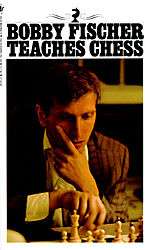Bobby Fischer Teaches Chess
 | |
| Author |
Bobby Fischer Stuart Margulies Don Mosenfelder |
|---|---|
| Country | United States |
| Language | English |
| Subject | Chess |
| Publisher | Basic Systems Inc, Bantam Books |
Publication date | 1966 |
| Pages | 352 |
| ISBN | 978-0553130539 |
Bobby Fischer Teaches Chess is a chess puzzle book written by Bobby Fischer and co-authored by Stuart Margulies and Don Mosenfelder, originally published in 1966. It is believed to be the best-selling chess book of all time, with over one million copies sold.[1]
Overview
The book is intended for beginners and uses a programmed learning approach,[2] permitting readers to go back and retry each question if they give a wrong answer. Unusually for a modern chess book, it requires no knowledge of chess notation, using only diagrams with arrows and verbal descriptions of chess moves such as "rook-takes-pawn-check".[3] The book begins with an explanation of the rules of chess. The puzzles focus exclusively on finding checkmate, beginning with mate in one move and moving on to mate in two, three and four. Combinations involving back rank mates are particularly emphasized.
Publishing history
The book was originally published in 1966 by Basic Systems Inc,[4] a subsidiary of Xerox.[5][6] A paperback edition was published by Bantam Books in 1967 and sold 10,000 copies by early 1972.[7] Due to the interest in the 1972 Fischer–Spassky World Championship match, sales increased dramatically and the book was reprinted eight times that year alone.[7]
In 1994, Interplay Entertainment released a computer chess program of the same name based on the book.[8] The software received mixed reviews, PC Gamer noting the "ugly 2-D board" and Entertainment Weekly describing the lessons as "humorless... dogmatic, and fearsome".[9]
Authorship
The extent of Fischer’s involvement in the book has been questioned. Andrew Soltis writes that Fischer "contributed some ideas, but chiefly his name".[10] Brady says that Fischer concentrated on working on it after the Capablanca Memorial in 1965 and that Mosenfelder, Margulies and Leslie Ault, who were all strong players as well as educational experts, "helped him in outlining and editing the work".[11] According to Margulies, Fischer wanted a high quality work free of any errors, so Michael Valvo and Raymond Weinstein were brought in as proof readers.[7]
Reception
Chiefly due to its accessibility for beginners and Fischer's high public profile, the book sold an estimated one million copies. It is difficult to determine chess book sales with certainty, but this figure, based on the royalty payments made to co-author Stuart Margulies, makes it a strong candidate for best-selling chess book of all time.[1] In October 1972, following Fischer's victory in the World Championship, the Bantam edition appeared on the New York Times Best Seller list at No. 2 on the general paperback list. It remained in this position for four weeks.[12]
Frank Brady, who was hired by Basic Systems as a promotional consultant, later said the book "lacked color or even a fleeting glimpse into the real way Bobby's mental processes work." and that it "was not ... one of the great introductory chess treatises of modern times."[11] The Times Literary Supplement, reviewing a 1973 British edition, criticized Fischer's grammar as well as the lack of content, which they said could have been compressed to fifty pages.[13]
Popular culture
The book remains in print and has achieved some degree of recognition in popular culture. Grandmaster Maurice Ashley has said that this was his first chess book, and it is referenced in Janet Fitch's novel White Oleander.[14]
See also
References
- 1 2 Winter, Edward. "Chess Book Sales". Retrieved September 5, 2018.
- ↑ Shelby Lyman on Chess: A World Class Teacher Archived October 26, 2015, at the Wayback Machine.
- ↑ "Bobby Fischer Teaches Chess". USCF Sales. Retrieved 10 April 2018.
- ↑ "Bobby Fischer Teaches Chess". Google Books. Retrieved 16 March 2017.
- ↑ Francis Mechner, Some Historic Roots of Education Reform (pdf)
- ↑ Winter, Edward (November 14, 2009). "C.N. 6371 – Fischer and Xerox". Chesshistory.com.
- 1 2 3 Donaldson, John; Tangborn, Eric (1999). The Unknown Bobby Fischer. International Chess Enterprises. p. 172. ISBN 9781879479852.
- ↑ Interplay Entertainment – Bobby Fischer Teaches Chess (Online)
- ↑ Moby Games,Bobby Fischer Teaches Chess Reviews, 1995
- ↑ Soltis, Andrew (2003). Bobby Fischer Rediscovered. B.T. Batsford Ltd. p. 10. ISBN 0-7134-8846-8.
- 1 2 Brady, Frank (1973). Bobby Fischer: Profile of a Prodigy. David McKay/Dover. p. 92. ISBN 0486259250.
- ↑ Justice, Keith L. (1998). Bestseller index : all books, by author, on the lists of Publishers weekly and the New York times through 1990. McFarland. p. 111. ISBN 0786404221.
- ↑ Times Literary Supplement, March 30 1973, p 362
- ↑ Fitch, Janet (1999). White Oleander. Little, Brown & co. ISBN 0-316-28526-9.
External links
- Bobby Fischer Teaches Chess at randomhousebooks.com